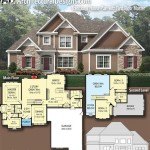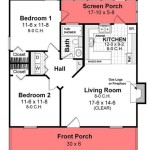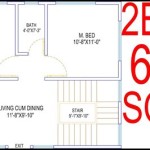A floor plan refers to a detailed drawing or diagram that depicts the layout of a building’s floor, including the arrangement of rooms, walls, doors, and windows. It serves as a visual representation of a building’s interior design and provides valuable insights into the spatial organization and functionality of each floor.
Floor plans are essential for the construction and planning of buildings, allowing architects, engineers, and contractors to visualize and plan the structure. They are used to determine room sizes, circulation patterns, and the placement of utilities such as electrical outlets, plumbing fixtures, and heating and cooling systems. Floor plans are also utilized for interior design purposes, assisting with furniture placement, lighting design, and overall aesthetic considerations.
In this article, we will delve deeper into the importance and applications of floor plans in the context of building a house, exploring their role in the design, construction, and interior layout of residential structures.
Floor plans are an integral part of the house building process, providing a blueprint for the construction and layout of the home. Here are 10 important points to consider when creating floor plans for building a house:
- Determine Room Sizes: Establish the dimensions and proportions of each room.
- Plan Circulation: Optimize the flow of movement between rooms.
- Position Utilities: Plan the placement of electrical outlets, plumbing fixtures, and HVAC systems.
- Maximize Natural Light: Position windows and doors to capture natural light.
- Consider Furniture Placement: Plan the layout to accommodate furniture and belongings.
- Establish Privacy: Designate private spaces for bedrooms and bathrooms.
- Incorporate Storage: Plan for adequate storage solutions throughout the house.
- Consider Accessibility: Ensure the home is accessible to all occupants.
- Reflect Personal Style: Design the floor plan to suit your taste and lifestyle.
- Follow Building Codes: Adhere to local building codes and regulations.
By carefully considering these points, you can create a floor plan that meets your specific needs and ensures a functional, comfortable, and aesthetically pleasing living space.
Determine Room Sizes: Establish the dimensions and proportions of each room.
Determining the room sizes is a crucial step in creating a floor plan, as it establishes the spatial dimensions and proportions of each room within the house. This involves carefully considering the intended use, furniture requirements, and desired atmosphere of each space.
- Consider Function: The primary function of each room should dictate its size. For example, a living room designed for entertaining may require more space than a cozy study.
- Plan for Furniture: Determine the necessary furniture for each room and allocate sufficient space for it. Consider the size and placement of beds, sofas, tables, and other furnishings.
- Create Proportional Rooms: Rooms should have balanced proportions to ensure a harmonious flow and aesthetic appeal. Avoid creating rooms that are too narrow or excessively elongated.
- Maximize Space Utilization: Optimize the use of available space by carefully planning the dimensions of each room. Avoid wasting space while ensuring that rooms are comfortable and functional.
By carefully considering these factors, you can establish room sizes that meet your specific needs and create a well-proportioned and functional floor plan for your house.
Plan Circulation: Optimize the flow of movement between rooms.
Planning circulation involves carefully designing the layout of rooms and spaces to ensure a smooth and efficient flow of movement throughout the house. This includes considering the placement of doors, hallways, and other transitional areas to minimize congestion and maximize convenience.
To optimize circulation, consider the following strategies:
- Create a Central Hub: Establish a central space or hallway that connects major rooms and areas of the house. This central hub serves as a distribution point, reducing the need for circuitous routes.
- Minimize Hallways: Use open floor plans or multi-purpose spaces to reduce the need for long, narrow hallways. When hallways are necessary, keep them short and well-lit.
- Position Doors Thoughtfully: Place doors in locations that minimize traffic flow disruptions. Avoid placing doors directly opposite each other, as this can create a bottleneck effect.
- Consider Traffic Patterns: Analyze how people will move through the house and plan the layout accordingly. Identify high-traffic areas and ensure they have sufficient space and clear pathways.
Optimizing circulation not only enhances the functionality of the house but also contributes to its overall livability and comfort. A well-planned circulation pattern reduces frustration, improves accessibility, and creates a more pleasant living environment.
When planning circulation, it’s essential to consider the specific needs and preferences of the occupants. For example, a family with young children may require wider hallways and open spaces to accommodate active play and movement, while an older couple may prefer a more compact layout with fewer obstacles.
By carefully considering circulation patterns and incorporating these strategies into your floor plan, you can create a house that is both functional and enjoyable to live in.
Position Utilities: Plan the placement of electrical outlets, plumbing fixtures, and HVAC systems.
The strategic placement of utilities, including electrical outlets, plumbing fixtures, and HVAC systems, is crucial when creating a functional and comfortable living environment. Electrical outlets should be conveniently located throughout the house to power appliances, electronics, and lighting fixtures. Plumbing fixtures, such as sinks, toilets, and showers, need to be positioned with access to water supply and drainage systems. HVAC systems, including heating, ventilation, and air conditioning units, should be placed to ensure efficient temperature regulation throughout the house.
When planning the placement of electrical outlets, consider the following factors:
- Appliance and Lighting Needs: Identify the locations of major appliances and lighting fixtures to ensure adequate outlet placement.
- Accessibility and Convenience: Place outlets in easily accessible locations, avoiding behind furniture or in awkward corners.
- Code Compliance: Adhere to local building codes and electrical safety regulations regarding outlet spacing and placement.
For plumbing fixtures, consider the following:
- Water Supply and Drainage: Plan the placement of fixtures near water supply and drainage lines to minimize plumbing costs and complexity.
- Functionality and Ergonomics: Position fixtures at appropriate heights and locations for comfortable and efficient use.
- Bathroom and Kitchen Layout: Designate specific areas for bathrooms and kitchens, grouping fixtures together for convenience.
When planning HVAC systems, consider the following:
- Heating and Cooling Needs: Determine the heating and cooling requirements of each room and select appropriate HVAC units.
- Airflow and Ventilation: Plan the placement of HVAC units and vents to ensure proper airflow and ventilation throughout the house.
- Energy Efficiency: Consider energy-efficient HVAC systems and placement strategies to minimize energy consumption.
By carefully planning the placement of utilities, you can create a house that is both functional and comfortable, ensuring that all essential services are conveniently accessible and efficiently utilized.
Maximize Natural Light: Position windows and doors to capture natural light.
Maximizing natural light in a house is crucial for creating a bright, inviting, and energy-efficient living environment. By strategically positioning windows and doors, you can harness the power of natural light to illuminate your home, reduce the need for artificial lighting, and enhance the overall ambiance.
- Maximize Window Size and Placement: Choose large windows and position them to capture the maximum amount of natural light. Consider floor-to-ceiling windows or large picture windows to allow ample light to flood the space.
- Orient Rooms Towards the Sun: Position rooms that require the most natural light, such as living rooms, kitchens, and bedrooms, on the south-facing side of the house. This orientation ensures maximum exposure to sunlight throughout the day.
- Avoid Obstructions: Ensure that windows and doors are not obstructed by trees, buildings, or other structures. Plan the landscaping and exterior design to complement the natural light strategy.
- Consider Skylights and Solar Tubes: Incorporate skylights or solar tubes to bring natural light into rooms that lack direct access to windows. These features can provide additional illumination without compromising privacy.
By carefully considering the placement of windows and doors, you can create a home that is filled with natural light, reducing energy consumption, improving mood, and enhancing the overall quality of living.
Consider Furniture Placement: Plan the layout to accommodate furniture and belongings.
When creating a floor plan, it is essential to consider furniture placement to ensure that the layout is both functional and aesthetically pleasing. This involves planning the arrangement of furniture within each room to optimize space utilization, create comfortable and inviting spaces, and facilitate smooth movement throughout the house.
To effectively plan furniture placement, consider the following strategies:
- Measure and Plan: Before arranging furniture, measure the dimensions of the room and furniture pieces to ensure they fit harmoniously. Plan the layout on paper or using design software to visualize the arrangement.
- Define Focal Points: Identify the focal points of each room, such as a fireplace, window, or artwork. Arrange furniture to draw attention to these features and create a sense of balance.
- Create Conversation Areas: In living rooms and family rooms, plan furniture arrangements that encourage conversation and interaction. Position chairs and sofas facing each other to create intimate seating areas.
- Consider Traffic Flow: Plan furniture placement to avoid obstructing traffic flow. Ensure there is ample space to move around the room and access doorways and windows without hindrance.
In addition to considering furniture placement within individual rooms, it is important to think about the flow and connection between rooms. Arrange furniture to facilitate movement and interaction between spaces, creating a cohesive and inviting home environment.
Furthermore, consider the storage needs of your belongings and plan for adequate storage solutions. Incorporate built-in storage, such as bookshelves, cabinets, and drawers, to keep belongings organized and out of sight. This helps maintain a tidy and clutter-free living space.
By carefully considering furniture placement and storage needs, you can create a floor plan that optimizes space utilization, enhances functionality, and creates a comfortable and stylish living environment.
Establish Privacy: Designate private spaces for bedrooms and bathrooms.
Creating a comfortable and private living environment is paramount when designing a floor plan. Establishing designated private spaces for bedrooms and bathrooms is essential for ensuring the privacy and well-being of the occupants. Bedrooms serve as sanctuaries for rest, relaxation, and personal time, while bathrooms are dedicated to personal hygiene and grooming. It is crucial to carefully consider the placement and design of these spaces to maximize privacy and create a sense of seclusion.
When planning the layout of bedrooms, consider the following strategies: Position bedrooms away from high-traffic areas and noise sources to minimize disturbances. Group bedrooms together in a dedicated wing or section of the house to create a sense of privacy and separation from common areas. Designate separate hallways or entrances for bedrooms to provide a buffer zone between private and public spaces. Utilize soundproofing techniques, such as insulation and double-glazed windows, to reduce noise transmission between bedrooms and other areas of the house.
Bathrooms, by their nature, require a high level of privacy. Consider the following guidelines when planning bathroom layouts: Position bathrooms adjacent to bedrooms to provide easy access while maintaining privacy. Designate separate bathrooms for different bedrooms or groups of bedrooms to avoid shared spaces and potential conflicts. Incorporate lockable doors and privacy locks on bathroom doors to ensure seclusion. Utilize frosted or opaque glass for bathroom windows to maintain privacy while allowing natural light to enter.
In addition to physical separation, consider the visual privacy of private spaces. Avoid placing windows or doors in bedrooms and bathrooms that directly face neighboring properties or public areas. Use landscaping, fences, or hedges to create visual barriers and maintain seclusion. By carefully considering these factors, you can create a floor plan that effectively establishes privacy for bedrooms and bathrooms, ensuring a comfortable and secure living environment for all occupants.
Establishing designated private spaces for bedrooms and bathrooms is not only about physical separation but also about creating a sense of sanctuary and retreat. By incorporating these strategies into your floor plan, you can design a home that provides both privacy and comfort, fostering a sense of well-being and relaxation for its occupants.
Incorporate Storage: Plan for adequate storage solutions throughout the house.
Adequate storage is crucial for maintaining a tidy and organized home. When planning a floor plan, incorporating well-thought-out storage solutions is essential to ensure that every item has a designated place, reducing clutter and maximizing space utilization.
Consider the following strategies to incorporate storage effectively:
- Built-in Storage: Utilize built-in storage solutions, such as bookshelves, cabinets, and drawers, to maximize vertical space and create a seamless, cohesive look. Built-in storage can be customized to fit specific needs and room configurations.
- Multi-Purpose Furniture: Choose furniture pieces that serve multiple functions, such as ottomans with built-in storage or beds with drawers. These pieces not only save space but also provide additional storage capacity.
- Hidden Storage: Incorporate hidden storage solutions, such as under-bed drawers, pull-out shelves, and secret compartments, to conceal clutter and maintain a clean and organized appearance.
- Utilize Vertical Space: Make use of vertical space by installing floating shelves, wall-mounted cabinets, and tall storage units. These solutions maximize storage capacity withouting valuable floor space.
When planning storage solutions, consider the specific needs of each room and its occupants. For example, kitchens require ample storage for cookware, utensils, and food items. Bedrooms need sufficient closet space for clothing, linens, and personal belongings. Bathrooms should have dedicated storage for toiletries, towels, and cleaning supplies.
In addition to dedicated storage spaces, consider incorporating flexible storage options, such as baskets, bins, and drawer organizers. These solutions provide additional storage capacity and help maintain organization within larger storage areas. By carefully planning and incorporating adequate storage solutions throughout the house, you can create a functional and clutter-free living environment that meets the needs of all occupants.
Incorporating adequate storage solutions is not only about maximizing space utilization but also about creating a sense of order and tranquility in the home. By providing designated places for everything, you can reduce clutter, simplify cleaning and maintenance, and enhance the overall livability and comfort of your home.
Consider Accessibility: Ensure the home is accessible to all occupants.
Accessibility is a crucial aspect of floor plan design, ensuring that the home is comfortable and functional for all occupants, regardless of their age, abilities, or physical limitations. By incorporating accessibility features, you create an inclusive living environment that promotes independence and enhances the quality of life for everyone.
To ensure accessibility, consider the following strategies:
- Wide Doorways and Hallways: Provide wider doorways and hallways to accommodate wheelchairs, walkers, and other mobility devices. Aim for a minimum width of 32 inches for doorways and 42 inches for hallways.
- Ramped Entrances: Incorporate ramps at entrances to eliminate steps and provide smooth access for wheelchairs and scooters. Ramps should have a gentle slope and non-slip surfaces.
- Roll-in Showers: Design bathrooms with roll-in showers that feature zero-threshold entry, grab bars, and a built-in seat. This allows individuals with mobility impairments to shower safely and independently.
- Accessible Kitchen: Plan the kitchen layout to ensure accessibility, including lower countertops, adjustable cabinets, and pull-out shelves. This enables individuals in wheelchairs or with limited reach to access and use the kitchen comfortably.
In addition to these specific features, consider the overall flow and layout of the home. Avoid sharp corners, narrow passages, and excessive clutter that can hinder movement. Ensure that all rooms and essential areas are easily accessible, minimizing the need for adaptations or assistance.
By incorporating accessibility features into your floor plan, you create a home that is not only comfortable and convenient for all occupants but also promotes dignity and independence. This thoughtful design ensures that everyone can fully enjoy their living space, fostering a sense of belonging and well-being.
Creating an accessible home is not just about meeting building codes or requirements; it is about creating a space that empowers all occupants to live their lives to the fullest. By considering accessibility in your floor plan, you demonstrate care and compassion for everyone who will call this house their home.
Reflect Personal Style: Design the floor plan to suit your taste and lifestyle.
Reflecting personal style in your floor plan is essential for creating a home that truly feels like your own. Consider your unique tastes, lifestyle, and aspirations to design a space that aligns with your personality and needs. This involves making choices that go beyond functionality and embrace aesthetics, comfort, and personal preferences.
- Customize Room Layouts: Break away from traditional room layouts and create spaces that suit your specific lifestyle. Whether you prefer an open-concept living area for entertaining or a dedicated home office for focused work, tailor the layout to your unique way of living.
- Incorporate Personal Touches: Add elements that reflect your personality and style, such as a cozy reading nook, a dedicated art display area, or a home gym tailored to your fitness routine. These personal touches make your home a true reflection of who you are.
- Choose Finishes and Materials: The choice of finishes and materials plays a significant role in shaping the overall ambiance of your home. Select flooring, wall coverings, and fixtures that align with your aesthetic preferences, whether it’s a rustic farmhouse style, a modern minimalist look, or a classic traditional design.
- Maximize Natural Light: If you prefer bright, airy spaces, design your floor plan to maximize natural light. Incorporate large windows, skylights, or sunrooms to bring the outdoors in and create a sense of spaciousness and tranquility.
By incorporating personal touches and reflecting your unique style throughout your floor plan, you create a home that is not only functional but also a true expression of yourself. Your home becomes a sanctuary that aligns with your personality and lifestyle, providing a sense of comfort, belonging, and inspiration.
Follow Building Codes: Adhere to local building codes and regulations.
Adhering to local building codes and regulations is a crucial aspect of floor plan design. Building codes are established to ensure the safety, stability, and habitability of structures. By following these codes, you not only comply with legal requirements but also guarantee that your home meets the minimum standards for construction and occupancy.
- Ensuring Structural Integrity: Building codes specify requirements for structural elements, such as foundations, framing, and roofing. These codes ensure that your home can withstand anticipated loads, including dead loads (permanent weight of the structure) and live loads (occupants, furniture, and other movable items).
- Maintaining Fire Safety: Building codes include fire safety regulations, such as the use of fire-resistant materials, the installation of smoke detectors, and the provision of adequate emergency exits. These measures help prevent the spread of fire and protect the occupants in case of an emergency.
- Promoting Health and Sanitation: Building codes address health and sanitation concerns by setting standards for ventilation, plumbing, and sewage systems. These regulations help ensure that your home has a clean and healthy indoor environment.
- Protecting the Environment: Building codes may include provisions to minimize the environmental impact of construction and occupancy. These provisions may include requirements for energy efficiency, water conservation, and the use of sustainable building materials.
Following building codes not only ensures compliance with legal requirements but also provides peace of mind knowing that your home is safe, habitable, and environmentally responsible. Ignoring building codes can lead to structural issues, safety hazards, and potential legal consequences.










Related Posts








